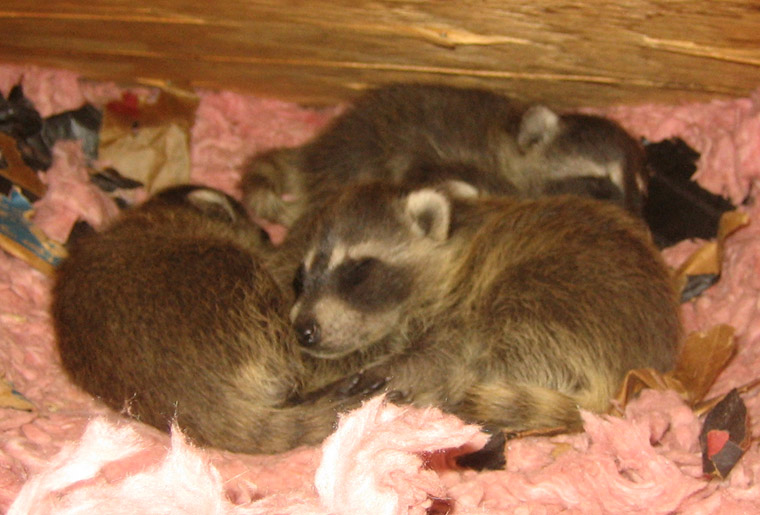- info@wildlife-removal.com
Call us for help in your town
Wildlife Removal Education
5 Signs of Baby Raccoons in the Attic
Need raccoon removal in your hometown? We service over 500 USA locations! Click here to hire us in your town and check prices - updated for year 2020.
It is actually quite common to find random wild animals in your attic, mostly because many property owners do not keep up with basic maintenance and inspections. Small holes easily become bigger ones, especially when sharp teeth and claws are used to battle through. Momma animals are a big fan of dark, warm, and relatively safe attic spaces which, in turn, means that the little things you keep hearing and potentially seeing could very well be a small family of furry animals. Raccoons are one of the most common culprits.

There are 5 signs of baby raccoons in the attic, and they are also common signs for other wild critters too. Knowing them can allow you to locate an animal control problem quickly, and resolve the problem as soon as possible.
1 - Vocal Sounds
Experts have established that raccoons have a very diverse and wonderful mix of vocal noises, used to communicate with each other and other animals. Over two hundred different sounds have been noted, ranging from low growls to high-pitched shrieks. Younger raccoons - kits - tend to make quieter and higher-pitched noises, such as crying and mewing. You may also hear something that closely resembles a whine.
Older raccoons tend to have slightly lower-pitched vocal noises, and have also been known to mimic the noises of other animals; although, it is not known whether or not they do this by accident or deliberately. It is quite common for homeowners to report foxes, owls, birds, bats, rats, opossums, and more, when what they actually have a problem with is raccoons.
2 - Other Sounds
Adult raccoons can weigh as much as twenty pounds, which means it'll make some noise as it moves around. The animal can get into all sorts of places it shouldn't, starting off on the roof before then making its way inside, falling into wall cavities, getting stuck in chimneys - You name it; you'll find the raccoon there. As it moves around, getting stuck and doing whatever it is that raccoons do, it will make a great deal of noise - thuds, bangs, scuffles, and dragging noises.
3 - Feces & Waste Material
Latrines are areas that raccoons like to go to the bathroom. They don't like these latrines to be too close to where they sleep - nesting areas. They also don't want latrines too close to where they eat either. (Would you?)
Raccoon poop can look very much the same as cat and dog poop, so don't be too quick to blame your pampered pooch for any messes that you find in places you shouldn't.
4 - Bedding/Nesting Material
Seeing the bedding and nesting material is a good sign, because then you're getting closer to the action. Sadly, homeowners rarely manage to find these bedding spots alone, without extended knowledge of the inner workings of the home, alongside behavioral knowledge of the animal.
5 - Visual Sightings
There is a pretty good chance that you won't actually ever see the animal (or animals) that you're up against, and that's because they don't want to be found. They keep themselves hidden away as best they can to keep themselves safe. Well, that's what a mother raccoon will do for her young; she will hide them in a spot that is tucked-away, dark, warm, and safe, not just to keep them warm and dry, but also to prevent them from coming under attack from predators, such as people.
In some cases, you might see the raccoon itself. They are mostly nocturnal creatures, but it isn't unusual for the animal to be out and about during the day, especially if there is plenty of food to be found or it is mating season.
If you suspect that you have raccoons in your attic, or anywhere else on your property, make sure that you attend to the problem as soon as possible. The signs of raccoons should not be ignored, unless you want a much bigger problems on your hands.
Go back to the Raccoon Removal page, or learn tips to do it yourself with my How to Get Rid of Raccoons guide.


















